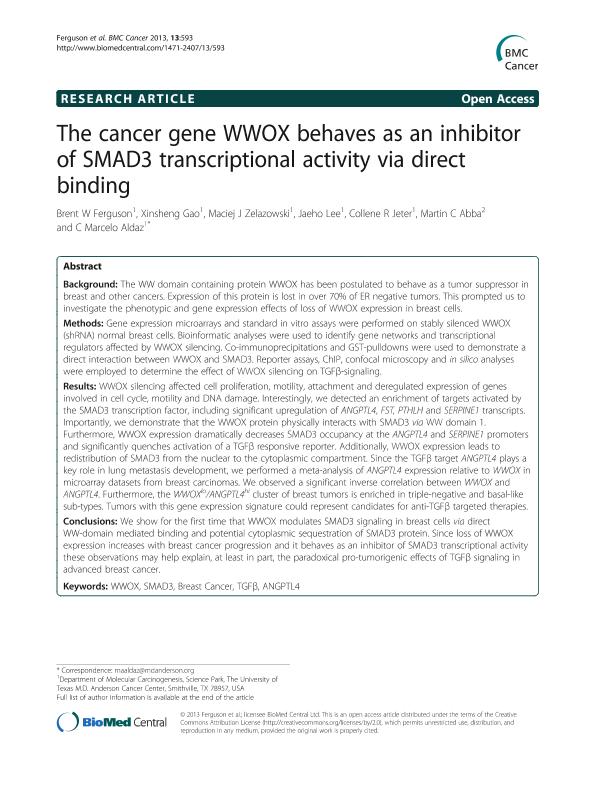Artículo
The cancer gene WWOX behaves as an inhibitor of SMAD3 transcriptional activity via direct binding
Ferguson, Brent W.; Gao, Xinsheng; Zelazowski, Maciej J.; Lee, Jaeho; Jeter, Collene R.; Abba, Martín Carlos ; Aldaz, Claudio Marcelo
; Aldaz, Claudio Marcelo
 ; Aldaz, Claudio Marcelo
; Aldaz, Claudio Marcelo
Fecha de publicación:
12/2013
Editorial:
BioMed Central
Revista:
BMC Cancer
ISSN:
1471-2407
Idioma:
Inglés
Tipo de recurso:
Artículo publicado
Resumen
Background: The WW domain containing protein WWOX has been postulated to behave as a tumor suppressor in breast and other cancers. Expression of this protein is lost in over 70% of ER negative tumors. This prompted us to investigate the phenotypic and gene expression effects of loss of WWOX expression in breast cells. Methods: Gene expression microarrays and standard in vitro assays were performed on stably silenced WWOX (shRNA) normal breast cells. Bioinformatic analyses were used to identify gene networks and transcriptional regulators affected by WWOX silencing. Co-immunoprecipitations and GST-pulldowns were used to demonstrate a direct interaction between WWOX and SMAD3. Reporter assays, ChIP, confocal microscopy and in silico analyses were employed to determine the effect of WWOX silencing on TGFβ-signaling. Results: WWOX silencing affected cell proliferation, motility, attachment and deregulated expression of genes involved in cell cycle, motility and DNA damage. Interestingly, we detected an enrichment of targets activated by the SMAD3 transcription factor, including significant upregulation of ANGPTL4, FST, PTHLH and SERPINE1 transcripts. Importantly, we demonstrate that the WWOX protein physically interacts with SMAD3 via WW domain 1. Furthermore, WWOX expression dramatically decreases SMAD3 occupancy at the ANGPTL4 and SERPINE1 promoters and significantly quenches activation of a TGFβ responsive reporter. Additionally, WWOX expression leads to redistribution of SMAD3 from the nuclear to the cytoplasmic compartment. Since the TGFβ target ANGPTL4 plays a key role in lung metastasis development, we performed a meta-analysis of ANGPTL4 expression relative to WWOX in microarray datasets from breast carcinomas. We observed a significant inverse correlation between WWOX and ANGPTL4. Furthermore, the WWOXlo/ANGPTL4hi cluster of breast tumors is enriched in triple-negative and basal-like sub-types. Tumors with this gene expression signature could represent candidates for anti-TGFβ targeted therapies. Conclusions: We show for the first time that WWOX modulates SMAD3 signaling in breast cells via direct WW-domain mediated binding and potential cytoplasmic sequestration of SMAD3 protein. Since loss of WWOX expression increases with breast cancer progression and it behaves as an inhibitor of SMAD3 transcriptional activity these observations may help explain, at least in part, the paradoxical pro-tumorigenic effects of TGFβ signaling in advanced breast cancer.
Palabras clave:
ANGPTL4
,
BREAST CANCER
,
SMAD3
,
TGFΒ
,
WWOX
Archivos asociados
Licencia
Identificadores
Colecciones
Articulos(CCT - LA PLATA)
Articulos de CTRO.CIENTIFICO TECNOL.CONICET - LA PLATA
Articulos de CTRO.CIENTIFICO TECNOL.CONICET - LA PLATA
Citación
Ferguson, Brent W.; Gao, Xinsheng; Zelazowski, Maciej J.; Lee, Jaeho; Jeter, Collene R.; et al.; The cancer gene WWOX behaves as an inhibitor of SMAD3 transcriptional activity via direct binding; BioMed Central; BMC Cancer; 13; 12-2013; 1-11
Compartir
Altmétricas



